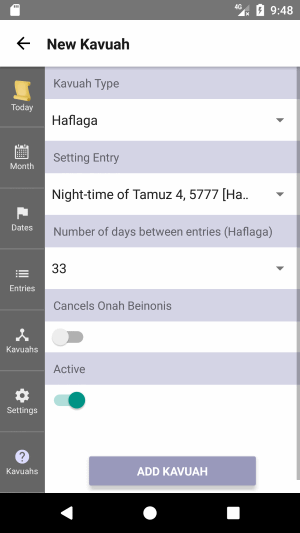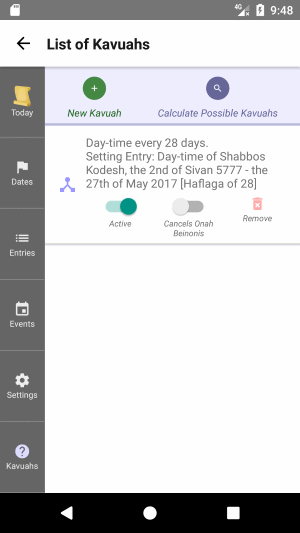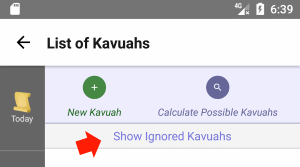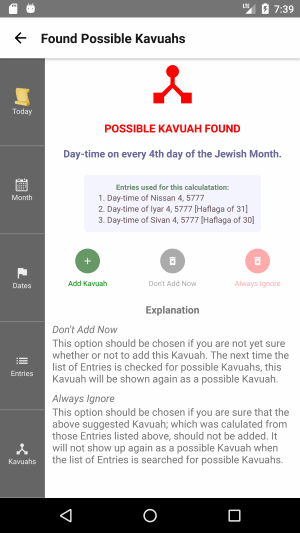

A Vesset Kavuah is a Halachic term describing when a women has multiple periods in a recurring pattern.
When a women has a set pattern, it is expected that periods will continue to occur in this pattern. This is until the pattern has been proven to have "broken".
Kavuah setting and breaking is a very complex Halachic issue and should aways be accompanied with Rabbinic guidance.
There are many ways that recurring periods can be considered to have occurred in a pattern.
Luach automatically calculates and suggests possible Kavuhas whenever an Entry is added or updated.
Here is a list of the Kavuah types that Luach knows how to calculate automatically:
Kavuahs have the following properties:
The type of Kavuah that is being set. For a brief explanation of some of the Kavuah types see the list above.Setting Entry
This is the final Entry of the Kavuah; the one that caused this Kavuah to be considered a pattern.Kavuah Defining Number
If you remove this Entry, the Kavuah will also be removed.
You cannot edit this Entry.
This is the number that defines the pattern for this Kavuah.Cancels Onah Beinonis
What this number represents is dependent upon the Kavuah type.
- For Yom HaChodesh / Day of Month Kavuahs, the Kavuah Defining Number is the day of the month.
- For Haflaga / Interval Kavuahs, the Kavuah Defining Number is the Haflaga - the number of days between the Entries.
- For Yom HaShavuah / Day of Week Kavuahs, the Kavuah Defining Number is the number of days between the Entries.
- For Dilug - Yom Hachodesh Kavuahs, the Kavuah Defining Number is the difference in day-of-month between each Entry in the pattern.
For example, if the Entries that set the pattern had the 5th, the 7th and the 9th of the month, the Kavuah Defining Number will be 2.
Starting from the Setting Entry (the one on the 9th of the month), Luach will add 2 days to each month to determine the Flagged Dates for this Kavuah.
If the pattern has a descending number of days, the Kavuah Defining Number will be a negative number.- For Dilug - Haflaga Kavuahs, the Kavuah Defining Number is the difference in Haflaga between each Entry in the pattern.
For example, if the Entries that set the pattern had Haflagas of 25, 27 and 29, the Kavuah Defining Number will be 2.
Starting from the Setting Entry (the one that had a Haflaga of 29), Luach will add 2 days to the Haflaga of the following Entries to determine the Flagged Dates for this Kavuah. If the pattern has a descending number of days, the Kavuah Defining Number will be a negative number.- For Sirug Kavuahs, the Kavuah Defining Number is the number of months that separate each Entry in the pattern from the previous one.
- For Haflaga of Onahs Kavuahs, the Kavuah Defining Number is the number of Onahs that separate each Entry in the pattern from the previous one.
This pertains to which Flagged Dates will show after this Kavuah is added.Active
If there was a Kavuah pattern with an especially strong Halachic status established, there are some Rabbinic opinions that the Kavuah may cancel all or some of the standard Flagged Dates that are often observed for a women who does not have any pattern at all.
These dates may include some or all of the following:
- The thirtieth day from the beginning of the period.
- The same day of the Jewish month for the month following the period.
- The thirty first day from the beginning of the period.
- The day that is the same number of days after the last period as that period was from the period preceding it. This is called the Yom Haflaga.
These standard Flagged Dates are called Onah Beinonis.
As with everything pertaining to Vesset Kavuahs, Rabbinic assistance is usually required to determine the correct course of action for setting the Cancels Onah Beinonis value for any Kavuah.
In Luach, when a new Kavauh is first added, it is initially set to not cancel Onah Beinonis.
If any Kavauh is set to cancel Onah Beinonis, from the day the Kavuah was set and onward, Luach will only show the Flagged Dates generated by that Kavuah.
All the Onah Beinonis Flagged Dates will not be shown.
Un-Cancelling
You can always remove the Cancel Onah Beinonis setting for any Kavuah from the Kavuahs Screen.
Just toggle the Cancels Onah Beinonis switch under that Kavuah.If there is a Kavuah in the list that is set to cancel Onah Beinonis, and a new Entry is added that does not fit the Kavuah pattern, Luach will ask you if you want to stop the cancelling of Onah Beinonis for this Kavuah.
This is in accordance with the Halacha.
It is important to note that there are some that are of the opinion that not all of the Onah Beinonis Flagged Dates return when there is a canceling Kavuah and there was a single period that was "out-of-pattern".
Luach does not (yet) have any option to cancel only some of the Onah Beinonis dates.Whenever any Kavuahs Cancels Onah Beinonis setting is changed, Luach will automatically recalculate all the Flagged Dates.
The same way that a pattern of Entries sets the Kavuah, a set of Entries that does not match the Kavuah can "break" the Kavuah pattern.
A broken Kavuah can be set to inactive to prevent it from causing any Flagged Dates.
For many Kavuah types, a broken Kavuahs can be reawakened again with a single Entry that matches the original pattern.
For this reason, it is usually recommended to de-activate a Kavuah rather than delete it.
Do to its high level of Halachic intricacy, Lauch DOES NOT automatically do any changes to a Kavuah even if it seems that
it should be considered broken or reawakened.
This is just one of the many reasons for the huge warning at the top of these pages about
how Luach can not be used to fully replace traditional methods of keeping track of a womens Halachic
calendar.
 The New Kavuah Screen
The New Kavuah Screen
 The Kavuah List Screen with one active and one inactive Kavuah
The Kavuah List Screen with one active and one inactive Kavuah
When Entries are added or changed, Luach automatically looks through the
entire Entry list to see if there may be a Kavuah pattern.
If a possible Kavuah is found, Luach will show The Possible Kavuah Screen.
Note:
If Luach finds a possible Kavuah that is already listed as an active Kavuah in the Kavuah
List Screen, it will not show it again as a possible Kavuah.
But if the found possible Kavuah is listed as inactive, it WILL be shown again as
a new possible Kavuah.
On the Possible Kavuah Screen, Luach will show:
Add this as a new Kavuah.Don't Add Now
Note, all Kavuahs are set by default to not Cancel Onah Beinonis. This can be changed later, in the Kavuah List Screen.
This option should be chosen if you are not yet sure whether or not to add this Kavuah. The next time the list of Entries is checked for possible Kavuahs, this Kavuah will be shown again as a possible Kavuah.Always Ignore
This option should be chosen if you are sure that the above suggested Kavuah; which was calulated from those Entries listed above, should not be added. It will not show up again as a possible Kavuah when the list of Entries is searched for possible Kavuahs.
For more information about ignored Kavuahs, see below.
 If a possible Kavuah
was shown in the Possible Kavuah Screen, and you chose the option "Always Ignore", Luach stores this
Kavuah as an Ignored Kavuah.
If a possible Kavuah
was shown in the Possible Kavuah Screen, and you chose the option "Always Ignore", Luach stores this
Kavuah as an Ignored Kavuah.
 The Possible Kavuah Screen.
The Possible Kavuah Screen.